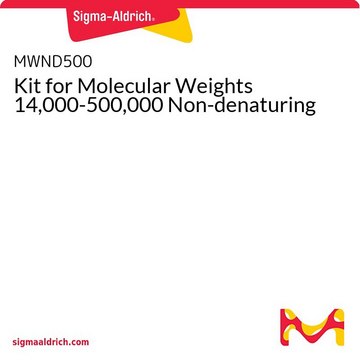S8445
SigmaMarker™
wide range, mol wt 6,500-200,000 Da
Sinonimo/i:
protein markers, protein standards
About This Item
Prodotti consigliati
Livello qualitativo
Forma fisica
lyophilized powder
impiego
sufficient for 10-20 large gels (16 × 18 cm)
sufficient for 20-30 mini-gels (10 × 10 cm)
1 vial sufficient for 50-100 PhastGels
PM
6,500-200,000 Da
Temperatura di conservazione
2-8°C
Cerchi prodotti simili? Visita Guida al confronto tra prodotti
Applicazioni
Altre note
Aprotinin, bovine lung (6,500)
α-Lactalbumin, bovine milk (14,200)
Trypsin inhibitor, soybean (20,000)
Trypsinogen, bovine pancreas (24,000)
Carbonic anhydrase, bovine erythrocytes (29,000)
Glyceraldehyde-3-phosphate dehydrogenase, rabbit muscle (36,000)
Ovalbumin, chicken egg (45,000)
Glutamic dehydrogenase, bovine liver (55,000)
Albumin, bovine serum (66,000)
Phosphorylase B, rabbit muscle (97,000)
β-Galactosidase, E. coli (116,000)
Myosin, porcine heart (200,000)
Ricostituzione
Note legali
Prodotti correlati
Avvertenze
Danger
Indicazioni di pericolo
Consigli di prudenza
Classi di pericolo
Eye Irrit. 2 - Resp. Sens. 1 - Skin Irrit. 2 - Skin Sens. 1
Codice della classe di stoccaggio
11 - Combustible Solids
Classe di pericolosità dell'acqua (WGK)
WGK 3
Punto d’infiammabilità (°F)
Not applicable
Punto d’infiammabilità (°C)
Not applicable
Dispositivi di protezione individuale
dust mask type N95 (US), Eyeshields, Faceshields, Gloves
Certificati d'analisi (COA)
Cerca il Certificati d'analisi (COA) digitando il numero di lotto/batch corrispondente. I numeri di lotto o di batch sono stampati sull'etichetta dei prodotti dopo la parola ‘Lotto’ o ‘Batch’.
Possiedi già questo prodotto?
I documenti relativi ai prodotti acquistati recentemente sono disponibili nell’Archivio dei documenti.
Il team dei nostri ricercatori vanta grande esperienza in tutte le aree della ricerca quali Life Science, scienza dei materiali, sintesi chimica, cromatografia, discipline analitiche, ecc..
Contatta l'Assistenza Tecnica.









